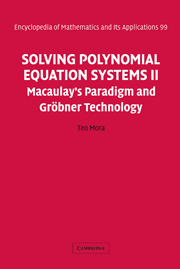23 - Macaulay I
from Part three - Gauss, Euclid, Buchberger: Elementary Gröbner Bases
Published online by Cambridge University Press: 05 June 2013
Summary
When Buchberger's algorithm (1965) became available within the algebraic geometry community, two unrelated results by Macaulay were seen in a different perspective. They are
• Macaulay's remark (Lemma 23.3.1 and Corollary 23.3.2) that an ideal I and its monomial ideal T(I) have the same Hilbert function, thus combinatorially allowing us to deduce information on H(T; I);
• the notion of H-basis (Definition 23.2.1) which mimics the notion of Gröbner bases using linear forms in place of maximal terms and whose computation was performed by Macaulay (Example 23.7.1) à la Buchberger by computing the syzygies among the leading forms of the bases and lifting them to relations between the basis elements.
The earliest research aimed at computing ideal theoretical problems by applying the Gröbner technology introduced by Buchberger was strongly infiuenced by these ideas of Macaulay; they provided a specific paradigm, which reduced the computational problems for ideals to the corresponding combinatorial problems over monomials. For instance:
• the problem of computing the Hilbert function of an ideal I, following Hilbert's argument, is easily reduced to a combinatorical inclusion-exclusion counting of monomials (Corollary 23.4.3);
• a deeper analysis and generalization of Macaulay's H-basis computation led Spear and Schreier to formulate and prove the Lifting Theorem (Theorem 23.7.3) which is the basis of the algorithms for computing resolutions.
- Type
- Chapter
- Information
- Solving Polynomial Equation Systems IIMacaulay's Paradigm and Gröbner Technology, pp. 109 - 169Publisher: Cambridge University PressPrint publication year: 2005

